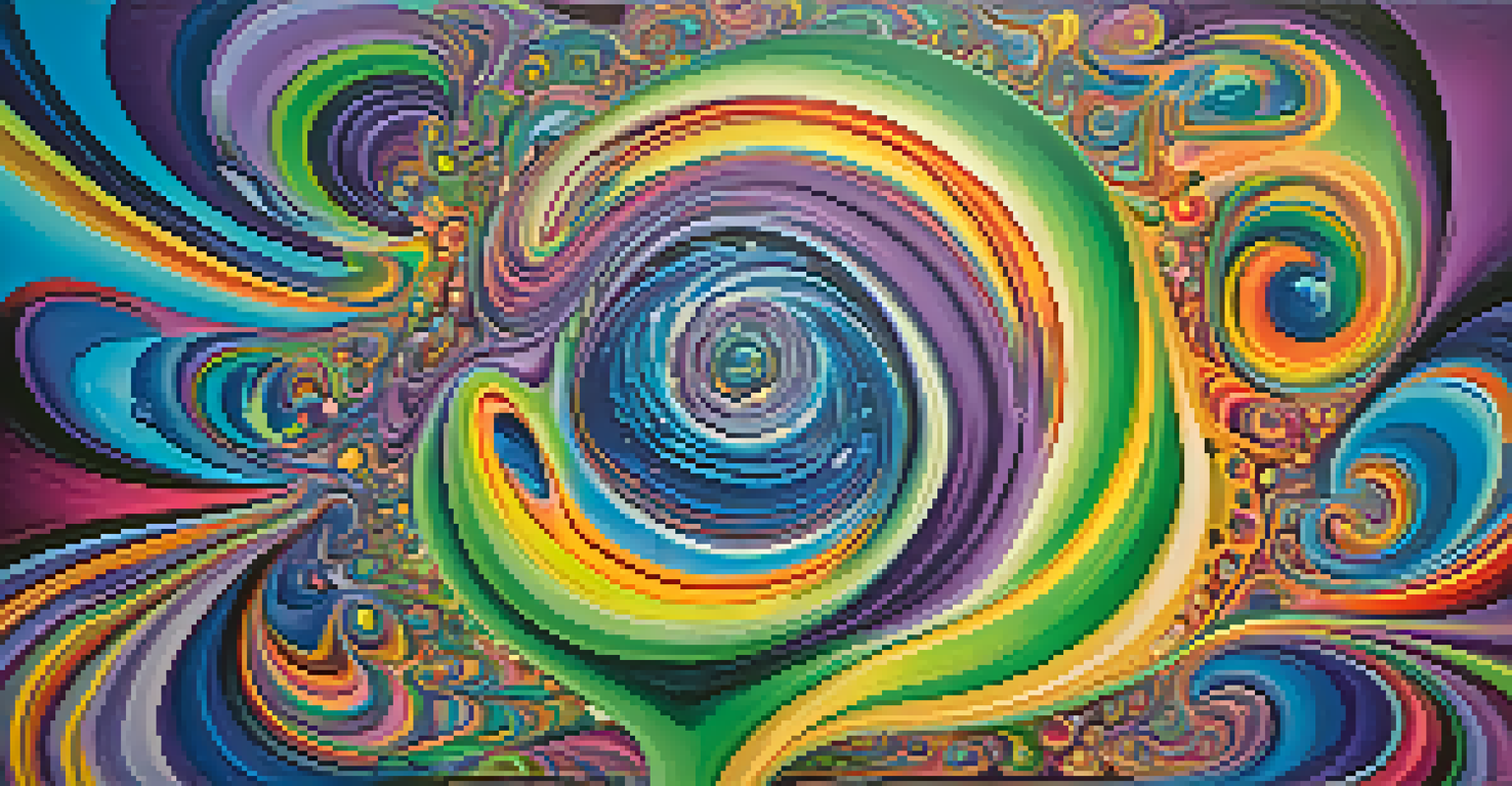Cognitive Effects: Peyote Compared to Psilocybin and LSD

Understanding Peyote: A Brief Overview
Peyote is a small cactus primarily found in Mexico and the southwestern United States. It contains mescaline, a psychoactive compound that has been used for thousands of years in spiritual rituals by Indigenous cultures. This plant is often celebrated for its profound effects on consciousness and perception, making it a unique player in the world of psychedelics.
Psychedelics can help us to see things differently, to understand the world and ourselves in a new light.
The experience of consuming Peyote is often described as deeply spiritual and introspective. Users may encounter vivid visual and auditory hallucinations, alongside a heightened sense of emotional awareness. These effects can lead to a transformative experience, fostering a connection with oneself and nature.
Interestingly, Peyote's effects can last up to 12 hours, significantly longer than many other psychedelics. This extended duration can allow for a more in-depth exploration of thoughts and feelings, making Peyote a powerful tool for self-discovery and healing.
Psilocybin: The Magic Mushroom Experience
Psilocybin, the active compound in magic mushrooms, is known for its ability to induce altered states of consciousness. Like Peyote, psilocybin has a rich history in various cultures, often used for spiritual and therapeutic purposes. Users report experiencing changes in perception, mood, and thought patterns, which can lead to profound insights.

The effects of psilocybin typically last between 4 to 6 hours, making it shorter in duration compared to Peyote. During this time, many users experience visual distortions, a sense of timelessness, and an altered sense of self. This can be both enlightening and, at times, overwhelming, depending on the individual’s mindset and environment.
Psychedelics Offer Unique Experiences
Each psychedelic—Peyote, psilocybin, and LSD—provides distinct cognitive effects that can lead to varied spiritual and introspective journeys.
Research has shown that psilocybin can significantly impact mental health, providing relief from depression and anxiety in some users. This therapeutic potential is a key reason for the growing interest in psilocybin-assisted therapy in today's mental health landscape.
LSD: The Synthesized Psychedelic
LSD, or lysergic acid diethylamide, was first synthesized in the 1930s and quickly became one of the most well-known psychedelics. Unlike Peyote and psilocybin, which are naturally occurring, LSD is a synthetic compound that can produce intense visual and auditory hallucinations. The experience can be both exhilarating and disorienting, leading to a wide range of cognitive effects.
The mind is like a parachute. It doesn't work if it is not open.
The effects of LSD can last anywhere from 8 to 12 hours, often characterized by heightened sensory perception and altered thought processes. Users frequently report experiencing a sense of interconnectedness with the universe and a breakdown of traditional boundaries of thought. This can lead to profound realizations or insights during the trip.
LSD is often associated with creativity and has been used by artists and thinkers to enhance their work. However, the intensity of the experience can vary greatly, making it essential for users to approach it with caution and awareness of their mental state.
Comparing Cognitive Effects: Peyote vs Psilocybin
When comparing Peyote and psilocybin, both offer transformative experiences but in different ways. Peyote can lead to deep emotional and spiritual journeys, while psilocybin often enhances introspection and personal insight. The visual and sensory experiences can be intense with both substances, but users may find the nature of their journeys differs significantly.
While Peyote is often linked to collective experiences and rituals, psilocybin tends to be more individualized, allowing for personal exploration. Users of Peyote may feel a stronger connection to nature and spirituality, while psilocybin users often report a greater focus on inner thoughts and feelings.
Duration Influences User Experience
The length of effects varies significantly, with Peyote lasting up to 12 hours, while psilocybin and LSD typically last between 4 to 6 and 8 to 12 hours, respectively.
Overall, both substances have the potential to facilitate personal growth and healing, but their cognitive effects can lead users on different paths of self-discovery.
Comparing Cognitive Effects: Peyote vs LSD
Peyote and LSD present contrasting experiences despite both being potent psychedelics. Peyote's effects are often described as more grounded and spiritual, whereas LSD can induce a more chaotic and intense experience. Users may find that Peyote fosters a sense of connection with the earth, while LSD encourages expansive and abstract thought.
The duration of the experiences also differs, with Peyote lasting longer than LSD. This extended experience can provide users of Peyote with ample time to reflect and integrate their insights. In contrast, LSD's shorter duration can lead to a rapid influx of thoughts and feelings, which may be overwhelming for some.
Ultimately, both substances can lead to significant cognitive shifts, but the nature of those shifts varies greatly. Understanding these differences can help users choose the right psychedelic for their needs.
Comparing Cognitive Effects: Psilocybin vs LSD
Psilocybin and LSD share similarities in their cognitive effects, but they also have distinct differences. Both can lead to altered perceptions and profound insights, yet psilocybin is often associated with a more introspective experience. In contrast, LSD can produce a more dynamic and sometimes erratic thought process, leading to bursts of creativity and new ideas.
The duration of effects is another notable difference: psilocybin typically lasts about 4 to 6 hours, while LSD can extend to 12 hours. This variance can impact the user's experience, as those on psilocybin may have a more manageable experience while still gaining valuable insights, whereas LSD may lead to longer periods of reflection.
Choose Based on Personal Goals
Selecting the right psychedelic should consider individual preferences, such as the desire for spiritual connection, introspection, or creativity.
Both substances also have therapeutic potential, but research is still ongoing to fully understand their effects on mental health. Users interested in exploring their consciousness might choose one over the other based on their desired journey.
Conclusion: Finding the Right Psychedelic for You
Choosing between Peyote, psilocybin, and LSD ultimately depends on personal preferences and goals. Each of these psychedelics offers unique cognitive effects that can lead to different experiences and insights. It's essential to consider factors like duration, intensity, and desired outcomes when making a choice.
For those seeking a spiritual connection and a longer journey, Peyote might be the right fit. If introspection and personal growth are the goals, psilocybin could provide a more suitable experience. Conversely, those looking for a burst of creativity and dynamic thought might find LSD to be the ideal option.

Regardless of the choice, it's crucial to approach these substances with respect and caution, ensuring a safe and meaningful exploration of consciousness.